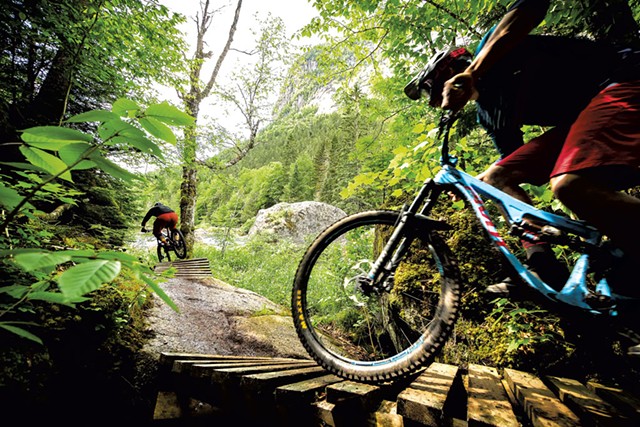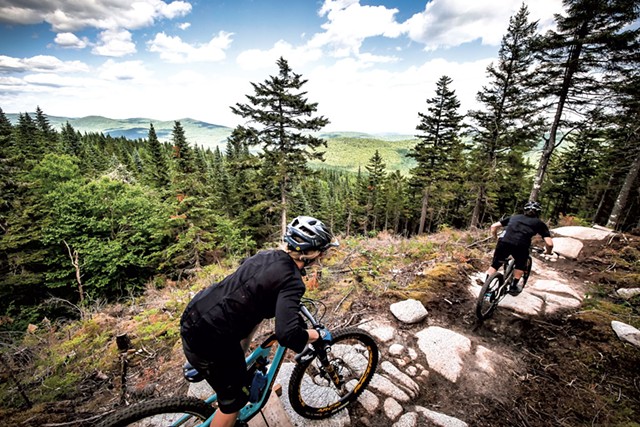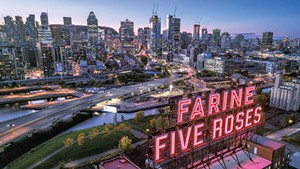
- Brice Shirbach
- Vallée Bras-du-Nord
Peering over the handlebars of my mountain bike, I checked out rock work and wooden bridges while climbing the Tourbillon trail through dense Québécois forest. The name translates to "eddy," which fits: It crosses the creek it follows over and over. Mist swallowed me, but just for a moment, as I pedaled through a dip, then along the next rocky spine toward a wooden pavilion at the cusp of the Slab City trail — a spot to catch my breath before a big, black-diamond descent.
Slab City, in the Maelstrom sector of Lac-Beauport's Sentiers du Moulin trail network, is a narrow and grippy strip of moss-edged granite that steps and drops its way downhill. It's popular: According to my Trailforks app, more than 48,000 mountain bikers have checked in at the top. Maneuvering past big views of the sprawling landscape, I forced myself to focus, tuning into the trail, my breathing and my brakes to keep my wheels on the granite as I snaked down the slope.
If Slab City is fun, it's also a poster child for the distinctive riding I've come to expect in the Québec City region. In the past 10 years, I've watched the area become one of the top mountain biking destinations in eastern North America, with four remarkable centers — Sentiers du Moulin, Vallée Bras-du-Nord, Empire 47 and Mont-Sainte-Anne — offering hundreds of miles of trails for cyclists of all skill levels. Riders now compare Québec City to Whistler, British Columbia, long a gold standard. A blistering pace of trail building in Québec, combined with supporting facilities and services, have elevated our neighbors up north to world-class status.
Leveling Up

- Brice Shirbach
- Sentiers du Moulin
Even a few decades ago, the trails at Mont-Sainte-Anne, an iconic network 25 miles northeast of Québec City, drew serious riders. But for years it was just Mont-Sainte-Anne; Vallée Bras-du-Nord didn't open to mountain bikes until 2008, followed by Sentiers du Moulin in 2010 and Empire 47 in 2014.
According to Québécois cyclist and Mountain Bike Hall of Famer Patrice Drouin, those networks put the region on the map as a riding destination. "Mont-Sainte-Anne isn't alone anymore," said Drouin, who would know — he opened Québec's first mountain bike shop, built its first trails, created its first race leagues and hosted its first World Cup, back in 1991.
Drouin now runs Auberge & Campagne, a small hotel five minutes from the Mont-Sainte-Anne trails. "Our guests pedal here for a few days, then use us as a base camp to explore Vallée Bras-du-Nord, Sentiers du Moulin and Empire 47. There is a different style of riding at each trail center. It's all well marked and well organized. Great infrastructure has boosted the sport drastically."
It's the outcome of years of planning and work, explained Nicolas Labrecque-Sauvé, director of cycling advocacy group Québec Vélo de Montagne. In 2014, tourism organization Destination Québec Cité joined forces with trail centers and private landowners to promote the region to tourists. The Town of Lac-Beauport also offered incentives for building trails — including allowing landowners to construct short-term rentals in exchange for 25 years of trail access.
"We put a lot of emphasis on the experience and quality of trail building, and we are very environmentally focused," Labrecque-Sauvé said. "We get all of the Québec City trail centers together at least a couple of times each year to share best practices and to brainstorm how to grow the sport here and how to draw visitors to enjoy the trails."
That means setting a high standard for quality and creativity as new trails are added. "Diversification is what makes visiting Québec so compelling for riders," Labrecque-Sauvé said. "There are new trails every year, and still, each area has its signature style."
Pedaling Progress

- Courtesy Of Laurent Bilodeau
- Empire 47
Such efforts have translated to a steady flow of riders visiting from outside the region. Labrecque-Sauvé said that of the 112,000 day passes sold at the Québec City area's four biggest pay-to-ride networks last year, about a quarter went to riders from Vermont and the northeastern United States.
"The rolling terrain and slabby granite — the steep and weathered tail of the Appalachian Mountains — gives this place its personality," said Delaware-based professional mountain biker Brice Shirbach, a frequent visitor to Québec trails for a decade. "Québec riding is like East Coast skiing. It's awesome in its own right, and honing your skills here sets you up for riding success almost anywhere."
Some come from farther afield. Last September, I met friends from Colorado in Québec City, and we made Vallée Bras-du-Nord our very first stop. We noodled alongside white-water rapids and followed a wiggly mess of flat trails sporting maple syrup-themed names. Flat doesn't mean easy: With its dips and dives, tree roots and twists, the route was blue, not green. Later, with our muscles limbered up, we tackled the more challenging Neilson East, the first leg of a classic all-day ride called the Full Neilson.
The trail snaked and dropped through dense hardwood forest, then popped out at waterfalls where we stopped to dunk our feet and helmets. We zipped through what felt like a dozen different ecosystems until we reached a lunch spot on the banks of the broad and powerful Bras-du-Nord River. From there, the trail rock-hopped along the riverbank, then eventually burrowed back into the trees.
Throughout, we found options to choose between A-lines and easier B-lines — the former a chance to learn, improve and push ourselves; the latter a boon for groups of friends whose talents and courage, on any given day, may vary. It was a master class in "progression," the idea that athletes can best improve when they have their pick of challenges. Stowe residents Kenzie and Cyril Brunner said the approach sets Québec cycling apart.
"At the Québec trail centers, Kenzie and I can both ride and push ourselves," Cyril Brunner said. "She's working on the tech, and I already love the crazier rock slabs and chunky terrain. But there's room for both of us to improve."
Even with lots of free-to-use trails close to home, he doesn't blink at Vallée Bras-du-Nord's fees. "Yeah, you have to pay to ride," Brunner said. "Even with the four-hour drive, it's worth it. In Vermont, the gap between intermediate and expert riding is huge. The Québec trails are designed to let you slowly work your way up through the degrees of difficulty."
Such design makes Québec riding a choose-your-own-adventure experience, and each rider I spoke with highlighted a different quality of the trails. Nick Bennette, executive director of the Vermont Mountain Bike Association, rides in Québec with friends and family at least a couple of times each summer. He comes for the descents, but he says the uphills are equally notable.
"Climbing trails at the Québec ride centers are pleasant. They're planned, not an afterthought," Bennette said. Meandering climbs (and, at Mont-Sainte-Anne, lifts) take riders to launch points with access to a plethora of downhills. Pedal up Milk Run at Empire 47, for instance, and you can go back down on any of eight blue, black and double-black descents. Grind up Montée Ravage, and there are 11 descents to choose from.
"You can do them with your 10-year-old," Bennette said. "No one goes to a network for the climbs, but that's where you spend 80 percent of your ride time. The climbs in Québec are built so that more people can enjoy the descents."
As Québec mountain biking has progressed, some close observers have noticed cross-pollination amid the switchbacks and stony descents on both sides of the border. A decade ago, Québec builders looked to Vermont's Kingdom Trails for guidance and inspiration; one day while riding there, I ran into a local friend, trail builder Knight Ide, giving the Vallée Bras-du-Nord crew a tour and a mini master class. The inspiration now flows both ways. Brunner is the designer behind Stowe's Serenity and Adrenaline. They're still under construction but already known for skinny bridges and an overdose of tech in a compact corridor. He modeled them after trails he rode in Sentiers du Moulin.
Carolyn Lawrence, executive director of Stowe Trails Partnership, a chapter of VMBA, said she took notice of Québec's liberality about e-bikes. While they're banned in many places across Vermont, in Québec they're generally allowed, for an upcharge. After riding in Québec, Lawrence advocated for e-bike access at home. "I was really excited about how many people I saw using Class 1 e-bikes on the trails in Sentiers du Moulin without user conflict," she said. "That encouraged me to work with the Town of Stowe to get e-bikes approved for Cady Hill and Sterling Forest."
Lawrence said she's still energized by the trails she's seen, and ridden, up north. "The rock work and features on the Québec trails are works of art," she said. "I like to brag about the infrastructure in Stowe, but in Québec City, there is just so much."
If You Go

- Courtesy Of Laurent Bilodeau
- Sentiers du Moulin
The four biggest mountain bike areas are within an hour of Québec City. Thirty-five miles to the northwest of downtown is Vallée Bras-du-Nord (valleebrasdunord.com, 800-321-4992, day passes CA$9.50-22.25, children 6 and under free); the Shannahan sector is cliffy with cascading rivers and waterfalls, and deep dives into the boreal forest snake through glacial debris.
Sentiers du Moulin (sentiersdumoulin.com, 418-849-9652, day passes CA$7.75-23, children 6 and under free), 15 miles north of the city, has a mix of cross-country and enduro trails on the trail-center side, with everything from flowy singletrack to chunky rocks and wooden features. On the Maelstrom side, it's a winding climb to the top of the best slab riding in the East. Directly west from there is Empire 47 (empire47.com, 418-848-8661, day passes CA$6-23, children 6 and under free with paying adult), whose jump lines, skills parks, pump track and airbag make this a great pick for building your bike-handling skills.
Pedal- and chair lift-accessible black and double-black trails at Mont-Sainte-Anne (mont-sainte-anne.com, 418-827-4561, trail-use day passes CA$20-30, all-day lift access CA$52-64, enduro tickets CA $42-48) bring in some of the best riders around, but cyclists of all skill levels can find their flow on newer green and blue routes. If you can't get enough in one day of riding, spend a night at Patrice Drouin's nine-room Auberge & Campagne (aubergeetcampagne.com, 581-982-4933, rooms CA$241). Or try the 166-site Mont-Sainte-Anne Campground (mont-sainte-anne.com/en/mont-sainte-anne-campground, 800-463-1568, sites from CA$47 a night). There will likely be mountain bikes at every site.








Comments
Comments are closed.
From 2014-2020, Seven Days allowed readers to comment on all stories posted on our website. While we've appreciated the suggestions and insights, right now Seven Days is prioritizing our core mission — producing high-quality, responsible local journalism — over moderating online debates between readers.
To criticize, correct or praise our reporting, please send us a letter to the editor or send us a tip. We’ll check it out and report the results.
Online comments may return when we have better tech tools for managing them. Thanks for reading.